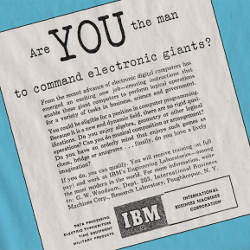
In the early months of 1956, an intriguing series of advertisements appeared in the New York Times, the Los Angeles Times, and Scientific American. Although the ads had been placed by the IBM Corporation, they were not selling any IBM products or services; rather, they were soliciting assistance from the public. Recent advances in electronic computing had created an unprecedented demand for computer programmers, the advertising copy declared, and in bold letters inquired of its readers, “Are you the man to command the electronic giants?” Because computer programming was a “new and dynamic” field, the advertisement argued, “there are no rigid qualifications.” Those individuals who enjoyed chess, music, or mathematics might consider themselves particularly suitable candidates, but the only real requirements were that you had an “orderly mind” and a “lively imagination.”5
These 1956 advertisements were not, of course, the first appeal for computer programmer talent launched by the IBM Corporation, or for that matter, by a whole host of computer manufacturers and users. Already by the late 1950s the growing demand for computer programmers was emerging as critical problem for the industry. But what makes this particular recruitment campaign significant was its emphasis on creativity and imagination. In fact, the ads were so intriguing as to attract the attention of the writers of the “Talk of the Town” column in the New Yorker magazine. Struck by the seeming incongruity between the appeal to both musicians and mathematicians, the “Talk of the Towners” themselves “made bold to apply” to the IBM manager in charge of programmer recruitment. “Not that we wanted a programming job, we told him; we just wondered if anyone else did.”3
The IBM manager they spoke to was Robert W. Bemer, a “fast-talking, sandy-haired man of about 35,” who, by virtue of his eight years experience was already considered, in the fast-paced world of electronic computing, “an old man with a long beard.” It was from Bemer that they learned of the 15,000 existing computer programmers. An experienced programmer himself, Bemer nevertheless confessed astonishment at the unforeseen explosion into being of a programming profession, which even to him seemed to have “happened overnight.” And for the immediate future, at least, it appeared inevitable that the demand for programmers would only increase. With obvious enthusiasm, Bemer described a near future in which computers were much more than just scientific instruments, where “every major city in the country will have its community computer,” and where citizens and businessmen of all sorts “grocers, doctors, lawyers” would “all throw problems to the computer and will all have their problems solved.” The key to achieving such a vision, of course, was the availability of diverse and well-written computer programs. And therein lay the rub for recruiters like Bemer: in response to the calls for computer programmers he had circulated in high-profile national newspapers and journals, he had received exactly seven replies. That IBM considered this an excellent return on its investment highlights the peculiar nature of the emerging programming profession.
Of the seven respondents to IBM’s advertisements, five were experienced programmers lured away from competitors. This kind of poaching occurred regularly in the computer industry, and although this was no doubt a good thing from the point of view of these well-paid and highly mobile employees, it only exacerbated the recruitment and retention challenges faced by their employers. The other two respondents were new trainees, only one of whom proved suitable in the long-term. The first was a chess player who was really “interested only in playing chess,” and IBM soon “let him go back to his board.” The second “knew almost nothing about computing,” but allegedly had an IQ of 172, and, according to Bemer “he had the kind of mind we like…[he] taught himself to play the piano when he was 10, working on the assumption that the note F was E. Claims he played that way for years. God knows what his neighbors went through, but you can see that it shows a nice independent talent for the systematic translation of values.”
In the period when IBM was still referring to computers as “electronic giants,” the problem of training and recruiting programmers was particularly apparent.
Eventually the advertising campaign and subsequent New Yorker coverage did net IBM additional promising programmer trainees, including an Oxford-trained crystallographer, an English Ph.D. candidate from Columbia University, an ex-fashion model, a “protohippie” and, of course, numerous chess players, including Arthur Bisquier, the U.S. Open Chess champion, Alex Bernstein, a U.S. Collegiate champion, and Sid Noble, the self-proclaimed “chess champion of the French Riviera.”4 The only characteristics these aspiring programmers appeared to have in common were their top scores on a series of standard puzzle-based aptitude tests, the ability to impress Bob Bemer as being “clever,” and, of course, the self-confidence to respond to vague but intriguing help-wanted ads.
Identifying Candidates
The haphazard manner in which IBM recruited its own top programmers, and the diverse character and backgrounds of these recruits, reveals much about the state of computer programming at the end of its first decade of existence. A quick tour through the industry literature from the late 1950s and early 1960s reveals numerous similar attempts to identify those unique individuals with the “right stuff” to become programmers. A 1962 advertisement from the RCA Systems Division, for example, appealed to those individuals with “a mind deep enough for Kant, broad enough for science fiction, and sufficiently precise to enjoy the esoteric language of the computer.”6 A tall order, indeed, particularly in a period in which very few people even knew what a computer language was, much less whether or not they would enjoy working with one.
The difficulty that firms like IBM and RCA had in defining what skills, knowledge, or training were essential to computer programming reflects both a specific moment in the history of electronic computing—the birth pangs of an industry that was only just coming into being—but also a more general truth about the distinctive character of computer programming as a discipline. From its origins, and to this day, computer programming has been regarded alternatively, and often simultaneously, as both a “black art” and an industrial discipline. Its practitioners run the gamut from Ph.D. computer scientists to self-taught 16-year-old “hackers.” As an intellectual and occupational activity, computer programming represents a peculiar amalgam of art, science, and engineering.
In the period when IBM was still referring to computers as “electronic giants,” of course, the problem of training and recruiting programmers was particularly apparent. If we take Bob Bemer’s reckoning as accurate, each new computer installation would require a support staff of at least 30 programmers. Since almost all computer programs in this period were effectively custom-developed—the packaged software industry would only begin to emerge in the late 1960s—every purchase of a computer required the corresponding hire of new programming personnel. Even if we were to halve Bemer’s estimates, the predicted industry demand for computer programmers in 1960 would top 80,000.
And where were all of these new programmers to come from? There were, in this period, no established programs in computer science; what formal academic training that did exist for computer programmers generally occurred within mathematics or electrical engineering departments (or was provided by the computer manufacturers). For the most part, programmers in this period learned on the job, developing their own tools, and inventing their own idiosyncratic techniques and solutions. As John Backus would later describe the situation, programming in the 1950s was “a black art,” “a private arcane matter,” in which “general programming principles were largely nonexistent [and] each problem required a unique beginning at square one.”1 It was not clear to anyone in this period what skills, training, or expertise were required to make a good programmer. It is no wonder, then, that corporate employers like IBM had difficulty identifying potential programmer trainees, and had to rely instead on vague notions of “orderliness” and “imagination.”
What emerges over the course of the next decade were a set of mechanisms for assuring an adequate supply of well-trained, experienced computer programmers. These included the establishment of formal programs in computer science, the establishment of professional societies, the publication of journals (it is no coincidence, for example, that Communications of the ACM first appeared in 1958). New technologies were developed that made computer programming less idiosyncratic, and new languages were introduced to help rationalize the process of programming (the first FORTRAN compiler was delivered in 1957, and the specification for COBOL was written in 1959). By the late 1960s computing was its own science, and proposals for incorporation of “software engineering” techniques were being developed. Employers such as IBM and RCA no longer had to look to chess players, musicians, and philosophers to staff their programming projects.
Nevertheless, the sense that computer programming was, at least in part, a distinctively creative activity, and that the very best programmers were gifted with a unique and idiosyncratic ability, remained a defining feature of the discipline. Throughout the 1960s and 1970s many corporate recruiters continued to rely heavily on the use of aptitude tests and personality tests aimed at identifying the “twinkle in the eye,” the “indefinable enthusiasm,” that marked those individuals possessed by “the programming bug that meant…we’re going to take a chance on him despite his background.”7 The IBM Programmer Aptitude Test (PAT), which had been developed by personnel psychologists in 1955 to help identify promising “programmer types,” continued to be used (albeit modified) well into the 1970s. It has been estimated that as many as 80% of the employers working in the field in that period had taken some form of the IBM PAT.
Conclusion
The curious persistence, well beyond the early, immature decades of electronic computing, of the notion that good computer programmers are “born, not made” can perhaps be interpreted as a sign of an ongoing lack of intellectual or professional rigor among programming personnel. But it is more likely, and more justified by the historical evidence, that the creative tension between art and science in computer programming has been one of the keys to the enormous productivity of the programming community, and to innovation in the software industry. In The Mythical Man-Month, for example, Frederick Brooks famously suggested that “the programmer, like the poet, works only slightly removed from pure-thought stuff. He builds his castles in the air, from air, creating by exertion of the imagination. Few media of creation are so flexible, so easy to polish and rework, so readily capable of realizing grand conceptual structures.”2 Far from criticizing the notion that programmers required a “lively imagination,” Brooks was embracing the fact. Like the IBM recruiters of an earlier era, he was identifying in computer programming those intangible qualities that made it one of the most novel and intriguing of the new technical disciplines to emerge during the great computer revolution of the mid-20th century.




Join the Discussion (0)
Become a Member or Sign In to Post a Comment